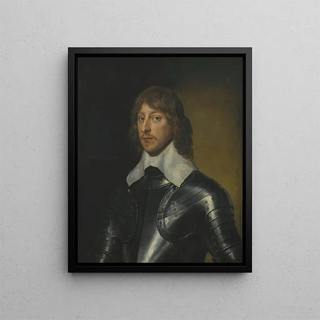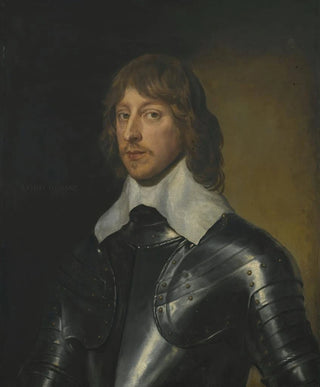Art print | Portrait of George Baron Goring - Antoine van Dyck


View from behind

Frame (optional)
The "Portrait of George Baron Goring" by Antoine van Dyck is an iconic artwork that embodies the very essence of baroque portraiture. This painting, created in the 17th century, immerses us in the refined world of English aristocracy. Gazing at this piece, one immediately perceives the psychological depth of the subject, captured with unparalleled technical mastery. George Goring's penetrating gaze, along with the richness of the details in his attire, testify to van Dyck's skill in immortalizing not only appearance but also the personality of his subjects. This art print invites us to rediscover a pivotal moment in art history, where portraiture becomes a reflection of grandeur and social status.
Style and uniqueness of the work
The uniqueness of the "Portrait of George Baron Goring" lies in how van Dyck combines realism and idealization. The painter manages to create an intimate atmosphere while highlighting the nobility of the character. The composition is carefully balanced, with light plays that emphasize facial features and the textures of clothing. The sumptuous drapery, painted with such precision, almost feels tangible, while the plain background accentuates the baron's presence. van Dyck uses a rich color palette, where warm tones and skillfully measured shadows give emotional depth to the piece. This portrait does not merely depict a man; it evokes a story, an era, and an identity.
The artist and his influence
Antoine van Dyck, a pupil of Rubens, is one of the most influential painters of the 17th century. His ability to capture the essence of his subjects revolutionized the genre of portraiture. As a court painter, he combined Flemish technique with a keen sense of psychology, which allowed him to stand out from his contemporaries. van Dyck not only shaped the style of baroque portraiture but also influenced generations of painters across Europe. His approach to portraiture, where the model is presented in all his dignity and complexity, paved the way for a new way of viewing human representation. The "Portrait of George

Matte finish

View from behind

Frame (optional)
The "Portrait of George Baron Goring" by Antoine van Dyck is an iconic artwork that embodies the very essence of baroque portraiture. This painting, created in the 17th century, immerses us in the refined world of English aristocracy. Gazing at this piece, one immediately perceives the psychological depth of the subject, captured with unparalleled technical mastery. George Goring's penetrating gaze, along with the richness of the details in his attire, testify to van Dyck's skill in immortalizing not only appearance but also the personality of his subjects. This art print invites us to rediscover a pivotal moment in art history, where portraiture becomes a reflection of grandeur and social status.
Style and uniqueness of the work
The uniqueness of the "Portrait of George Baron Goring" lies in how van Dyck combines realism and idealization. The painter manages to create an intimate atmosphere while highlighting the nobility of the character. The composition is carefully balanced, with light plays that emphasize facial features and the textures of clothing. The sumptuous drapery, painted with such precision, almost feels tangible, while the plain background accentuates the baron's presence. van Dyck uses a rich color palette, where warm tones and skillfully measured shadows give emotional depth to the piece. This portrait does not merely depict a man; it evokes a story, an era, and an identity.
The artist and his influence
Antoine van Dyck, a pupil of Rubens, is one of the most influential painters of the 17th century. His ability to capture the essence of his subjects revolutionized the genre of portraiture. As a court painter, he combined Flemish technique with a keen sense of psychology, which allowed him to stand out from his contemporaries. van Dyck not only shaped the style of baroque portraiture but also influenced generations of painters across Europe. His approach to portraiture, where the model is presented in all his dignity and complexity, paved the way for a new way of viewing human representation. The "Portrait of George






